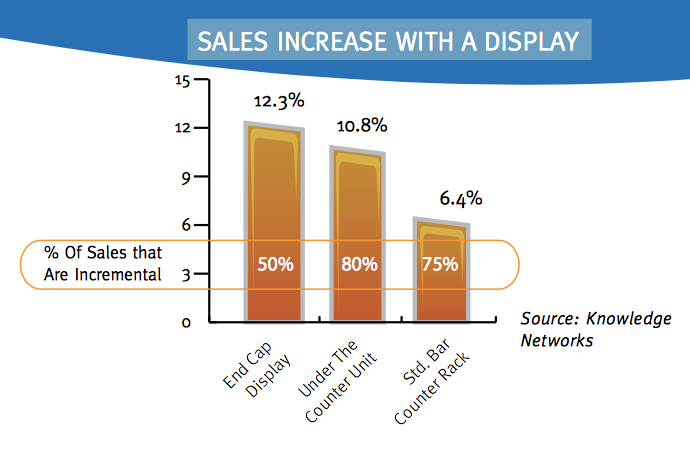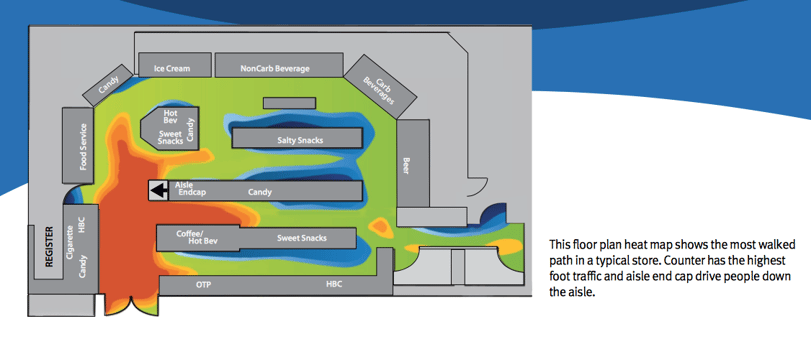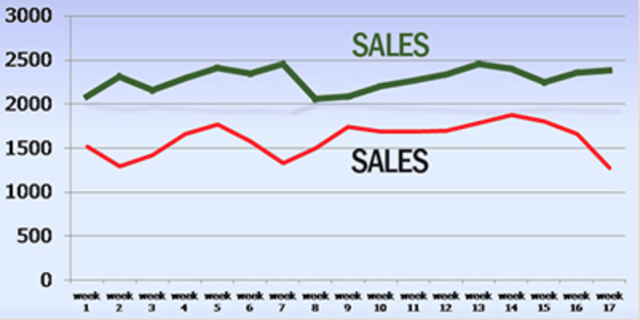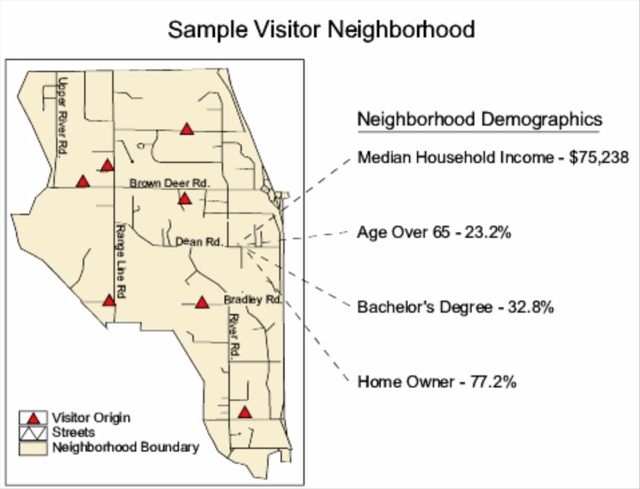Successful merchandising is the driving factor behind sales. But how much does each component of merchandising impact your sales growth and in what way? By evaluating your field reps’ performance in each of these categories, you can gain better insight as to where you should focus your efforts for optimal performance on the shelves. In this post, we explore nine focus areas your field reps must master to maximize your brand's sales in retail.
1. Merchandising Shelves
2. Restocking and Reordering Products
3. Setting Up POP Displays
4. Negotiating Additional Placements
5. Correcting Voids
6. Monitoring Competition
7. Enforcing Planogram Resets
8. Opening New Outlets
9. Gathering Demographic Data
1. Merchandising Shelves
One of the most important aspects of visual merchandising is organizing the shelves. A clean, well-maintained shelf will look more appealing to customers than a messy, nearly empty shelf. You want your reps to pull all of your products up to the front and have them facing the same way.
If certain products are running low on inventory, reps can make shelves look more full by displaying double rows of the product. There should not be any misplaced items on the same shelf as yours, nor should there be any gaps where your products should be.
2. Restocking and Reordering Products
Stores don’t always pull products from the back room onto the shelf. Thus it’s important to make sure that there is enough product on the shelf to sell and enough in the back room to restock the shelves. When out-of-stock instances occur, the supplier loses much more than the retailer; therefore, the retailer has less incentive to restock or pull product from the back than suppliers do. Restocking as needed is imperative for avoiding OOS instances.
Out-of-stocks result in a direct loss of brand loyalty and equity, and encourage shoppers to reach for competitors' products, Procter & Gamble found. This means that OOS instances not only cause brands to lose sales revenue in the short-run, but also future sales revenue as long-time customers transition find new favorites.
It is important to collect data about OOS - by recording and analyzing data, you can detect patterns in OOS instances, which makes them easier to prevent in the future.
If the product does happen to be out of stock, your reps need to have the ability to reorder products. Having order histories for each account makes it easier to determine how much to order the next time around.
The reordering process may differ according to the retailer - some will have reps write down the order and leave it with the store manager, some will have reps submit orders electronically, and some will have reps send orders directly to the distributor.
Whichever form reps use, the most important factor is that they're able to trigger reorders as needed, so that out-of-stock products can be quickly delivered to the retailer and put on the shelf for customers to buy.
3. Setting Up POP Displays
POP displays are important because most customers do not shop with a physical checklist - 34% of shoppers don’t have a list at all, while 47% rely on a mental shopping list, according to a 2012 POPAI Mass Merchant Study. This makes shoppers more prone to impulse buys. Of the sixty-two percent of shoppers that pick up items on impulse, 16% did so because of a prominent display.
The graph below shows the percent increase in sales when implementing POP displays at various locations in the store. As you can see, effective POP displays can boost sales by more than 12%. Maximize the benefits of this by making sure that your field rep knows how to set up a POP display, as well as know where to set it up. If it is the retailer’s job to set up displays, have the rep confirm that it is set up properly, since retailers can sometimes neglect to set up the display.

(Source)
4. Negotiating Additional Placements
By enabling your field reps to negotiate additional placements, you can potentially increase your sales - but only if you believe that you would benefit from additional facings, especially from impulse buying. The heat map below shows high-traffic areas in a typical store - securing secondary placements in these areas could improve impressions and sales.
 (Source)
(Source)
To help your reps successfully negotiate for these spots in the store, try giving them a checklist of what to say and/or tips and tactics for a successful negotiation. For example, Dean James, the former VP of Corporate Sales at DuPont, suggests that reps come to negotiations armed witha “road map” of what they’re going to say:
They should anticipate what questions the retailer would ask and what negotiables they should offer to the retailer. Second, they should discuss value instead of price. Instead of speaking about price early on, reps should demonstrate to the retailer how their store(s) will benefit from additional facings.
Once the rep understands the retailer’s needs, they can better adjust their negotiation to maximize the value of their proposition to both parties involved. Finally, although the rep may have to make some concessions, the main point is to “exchange value, not give it away.” Both the rep and the retailer should come to a compromise where both parties are happy and have an agreement that benefits everyone involved.
If your reps have good negotiation skills, you should enable them to sell additional SKUs as well. For example, if your current retailer carries two flavors of your beverage and they are both selling well, try having your field rep convince the retailer to sell an additional flavor. Like negotiating additional placements, this takes finesse and you may want to provide your rep with materials to present a strong argument for the retailer to carry additional SKUs. The more of your products the retailer carries the better, so if the opportunity should arise, empower your field rep to make this negotiation.
5. Correcting Voids
Although many believe that stockouts are the biggest issue merchandisers have to face, product voids are more serious. With a void, not only is the product out of stock, but there is no longer a space for it on the shelf.
How does this happen? If your product sells out and the shelf tag happens to fall off, an employee may rearrange the shelf so that there are no gaps, not knowing that there was a product that was supposed to be there. Then, when your field rep goes to check in on the shelves, they don’t know that that particular product was supposed to be there, so they don’t reorder it. This results in your product virtually disappearing; it not only goes out of stock but out of distribution as well.
This is an issue because it is probably your most popular product, since it sold out the fastest. This issue is hard to catch without order history data, and will lose you a lot of money if not corrected. An easy way to prevent this is to by giving your field team access to a list of all the products that should be on the shelf, as well as the products that were placed in the last order.
6. Monitoring Competition
In order to remain relevant in today’s markets, you need to be aware of what your competitors are doing and be able to adjust accordingly. Have your merchandising team record your competitors' price, promotions, labels, shelf location, and packaging, as well as any other metrics you wish to keep tabs on. By collecting data on your competitors, you can practice competitive pricing and learn from their successes or losses.
Different venues also have different prices - for example, specialty retailers might charge more for certain items than convenience stores. It is therefore important to maintain pricing records at every location where you distribute your product.
7. Enforcing Planogram Resets
Resets typically happen when new products move in, promotions begin, or the seasons change. They are an integral part of merchandising as the new look stimulates customer interest. Products and POP signs are usually switched out as well, so you want to ensure that your reps do this correctly. When your reps are performing planogram resets, have them send a picture of their completed reset.
This may not necessarily be for you to identify the before and after effects of the reset; rather, it is a good way to ensure accountability and motivate your field rep to do the reset to the best of their ability. These resets are important to your sales growth - 100% reset compliance can mean a sales lift of 7.8% and a profit improvement of 8.1% within two weeks, according to a benchmark study by the National Association for Retail Merchandising.
In one specific case study, careful planogram resets boosted sales and profits by more than 40 percent each, illustrated in the graph below.

(Source)
8. Opening New Outlets
Since you already have a team of reps in the field, you can send them to identify potential retailers and/or capture any leads. According to Bloomberg BusinessWeek, some questions for reps to ask themselves when identifying potential retailers are: “How many stores does this client have? How much sales volume do they do? Are they in your product or customer category?”
If they think that these retailers are a good fit and that more retailers in their territory could carry their product, give your field reps the freedom to follow this lead and possibly gain you another retail location.
9. Gathering Demographic Data
Demographic data is important because the more you know about your customers, the easier it is to market successfully to them. The more data you collect, the more you can focus your marketing to the needs of your target market. You will also gain better insight as to what products to distribute to what retailers.
Collect data on the neighborhood around the retail location (is it urban, suburban, or rural?), the income of the people living in the neighborhood (can be inferred by collecting data on the types of homes or cars in the area), and the gender, age, and ethnicity of the residents, to name a few factors.
By having your field reps regularly gather demographic data, you can see demographic shifts in each territory. Since these shifts can result in a shift in customer needs and tastes, you will be ready to adjust your product distribution as needed.
The example below from The University of Wisconsin shows the results of a demographic survey of one store neighborhood. With demographic data organized and illustrated clearly, it's easy to create and target a store-specific shopper persona.

(Source)
The Impact
With each of these factors, you can decide how much impact they should have on your business. However, it is important to be aware of the fact that each of these factors has the potential to have a major impact on your sales growth.
Ask yourself this question: How good are your field reps at completing each task? If you look at the most successful businesses out there, you’ll see that they’re all experts at merchandising. Merchandising directly impacts sales growth, and in order to maximize your growth, you need to be able to measure how effective you are at each facet of merchandising.








